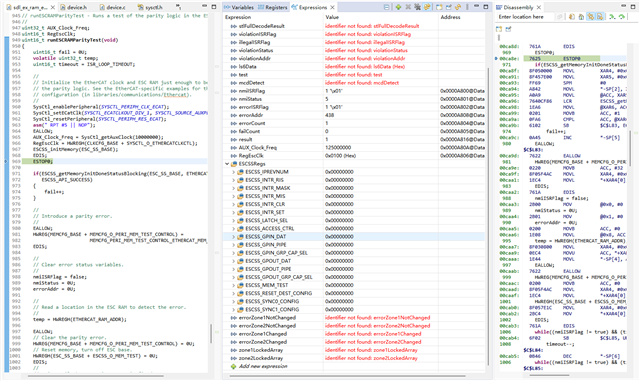Other Parts Discussed in Thread: TMDSCNCD28388D
首先device.h里面添加的符合10MHz晶振源的时钟链应该是没问题的,如下。
//
// 10MHz XTAL on eRob-Master. For use with SysCtl_getClock() and
// SysCtl_getAuxClock().
//
#define DEVICE_OSCSRC_FREQ 10000000U
//
// Define to pass to SysCtl_setClock(). Will configure the clock as follows:
// PLLSYSCLK = 10MHz (XTAL_OSC) * 80 (IMULT) / (2 (REFDIV) * 2 (ODIV) * 1(SYSDIV))
//
#define DEVICE_SETCLOCK_CFG (SYSCTL_OSCSRC_XTAL_SE | SYSCTL_IMULT(80) | \
SYSCTL_REFDIV(2) | SYSCTL_ODIV(2) | \
SYSCTL_SYSDIV(1) | SYSCTL_PLL_ENABLE | \
SYSCTL_DCC_BASE_1)
//
// 200MHz SYSCLK frequency based on the above DEVICE_SETCLOCK_CFG. Update the
// code below if a different clock configuration is used!
//
#define DEVICE_SYSCLK_FREQ ((DEVICE_OSCSRC_FREQ * 80) / (2 * 2 * 1))
//
// 50MHz LSPCLK frequency based on the above DEVICE_SYSCLK_FREQ and a default
// low speed peripheral clock divider of 4. Update the code below if a
// different LSPCLK divider is used!
//
#define DEVICE_LSPCLK_FREQ (DEVICE_SYSCLK_FREQ / 4)
//
// Define to pass to SysCtl_setAuxClock(). Will configure the clock as follows:
// AUXPLLCLK = 10MHz (XTAL_OSC) * 50 (IMULT) / (2 (REFDIV) * 2 (ODIV) * 1(AUXPLLDIV) )
//
#define DEVICE_AUXSETCLOCK_CFG (SYSCTL_AUXPLL_OSCSRC_XTAL | SYSCTL_AUXPLL_IMULT(50) | \
SYSCTL_REFDIV(2U) | SYSCTL_ODIV(2U) | \
SYSCTL_AUXPLL_DIV_1 | SYSCTL_AUXPLL_ENABLE | \
SYSCTL_DCC_BASE_0)
//
// 125MHz AUXCLK frequency based on the above DEVICE_AUXSETCLOCK_CFG. Update
// the code below if a different clock configuration is used!
//
#define DEVICE_AUXCLK_FREQ ((DEVICE_OSCSRC_FREQ * 50) / (2 * 2 * 1))
前面三项测试runParityTest、runCorrectableECCTest、runUncorrectableECCTest都正确通过,故障关键是runESCRAMParityTest测试项目里的ESCSS_initMemory(ESC_SS_BASE);
该步骤未能真实启动ESCSS。
直接用例程测试没通过,下面是我添加了测试标记的runESCRAMParityTest函数。
//
// runESCRAMParityTest - Runs a test of the parity logic in the ESC RAM.
//
uint32_t AUX_Clock_Freq;
uint16_t RegEscClk;
uint16_t runESCRAMParityTest(void)
{
uint16_t fail = 0U;
volatile uint32_t temp;
uint16_t timeout = ISR_LOOP_TIMEOUT;
//
// Initialize the EtherCAT clock and ESC RAM just enough to be able to test
// the parity logic. See the EtherCAT-specific examples for the full
// configuration (in libraries/communications/Ethercat).
//
SysCtl_enablePeripheral(SYSCTL_PERIPH_CLK_ECAT);
SysCtl_setECatClk(SYSCTL_ECATCLKOUT_DIV_1, SYSCTL_SOURCE_AUXPLL, 1);
SysCtl_resetPeripheral(SYSCTL_PERIPH_RES_ECAT);
asm(" RPT #5 || NOP");
EALLOW;
AUX_Clock_Freq = SysCtl_getAuxClock(10000000);
RegEscClk = HWREGH(CLKCFG_BASE + SYSCTL_O_ETHERCATCLKCTL);
ESCSS_initMemory(ESC_SS_BASE);
EDIS;
ESTOP0;
if(ESCSS_getMemoryInitDoneStatusBlocking(ESC_SS_BASE, ETHERCAT_RAM_TIMEOUT) !=
ESCSS_API_SUCCESS)
{
fail++;
}
//
// Introduce a parity error.
//
EALLOW;
HWREG(MEMCFG_BASE + MEMCFG_O_PERI_MEM_TEST_CONTROL) =
MEMCFG_PERI_MEM_TEST_CONTROL_ETHERCAT_MEM_FORCE_ERROR;
EDIS;
//
// Clear error status variables.
//
nmiISRFlag = false;
nmiStatus = 0U;
errorAddr = 0U;
//
// Read a location in the ESC RAM to detect the error.
//
temp = HWREGH(ETHERCAT_RAM_ADDR);
EALLOW;
// Clear the parity error.
HWREG(MEMCFG_BASE + MEMCFG_O_PERI_MEM_TEST_CONTROL) = 0U;
// Reset memory, turn off ESC base.
HWREGH(ESC_SS_BASE + ESCSS_O_MEM_TEST) = 0U;
EDIS;
//
// Wait until the error interrupt is fired.
//
while((nmiISRFlag != true) && (timeout != 0U))
{
timeout--;
}
//
// Check if interrupt occurred as expected or if the loop timed out.
//
if(timeout == 0U)
{
fail++;
}
//
// Check if the NMI triggered was due to an uncorrectable RAM error.
//
if((nmiStatus & SYSCTL_NMI_RAMUNCERR) != SYSCTL_NMI_RAMUNCERR)
{
fail++;
}
return(fail);
}
调试表现如下图。左边为刚执行完ESCSS_initMemory的样子,右边为跑完runESCRAMParityTest的样子。


你觉得是什么原因造成了ESCSS启动失败,有没有可能ESC_SS_BASE的值有问题?
